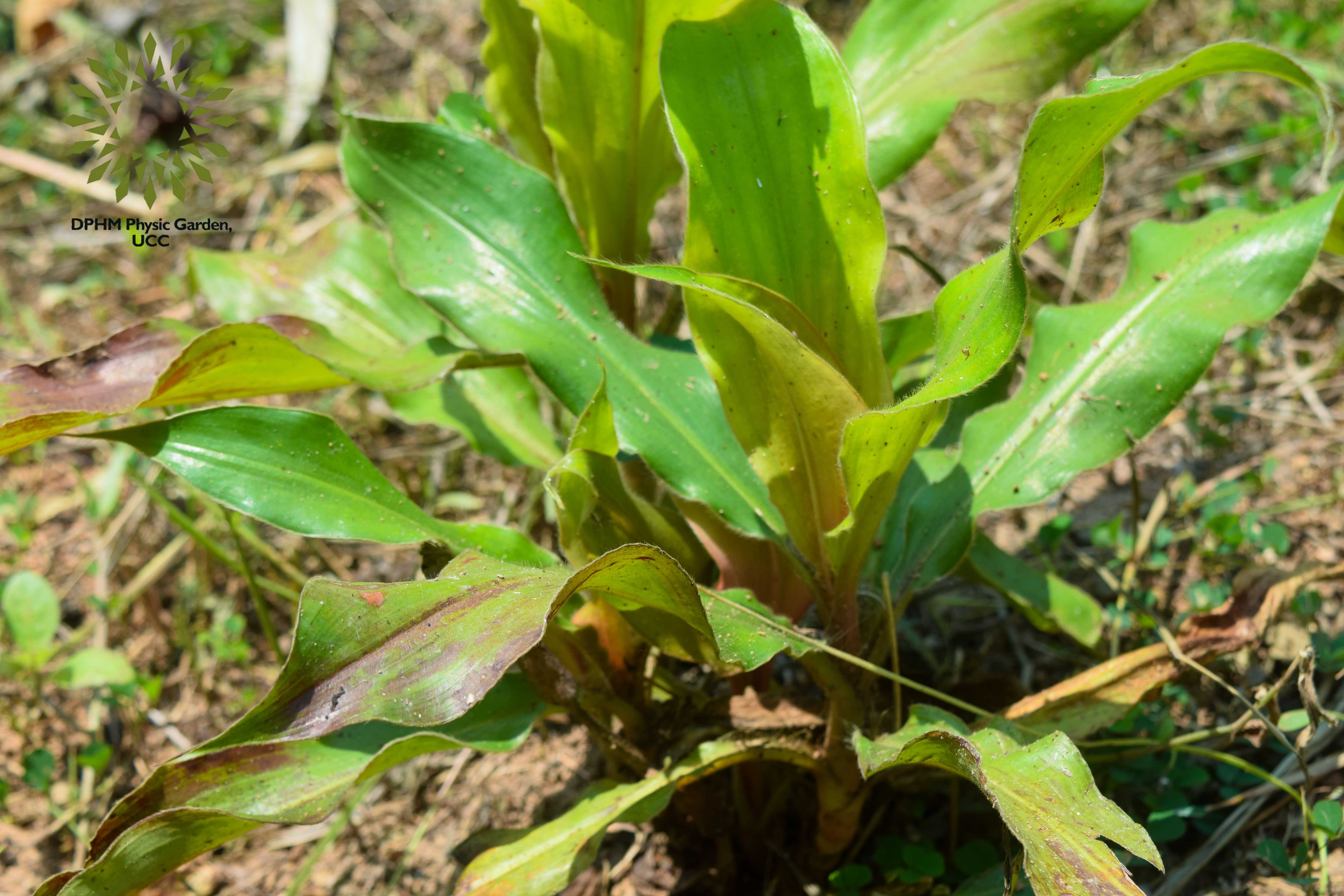PALISOTA HIRSUTA
BOTANICAL DESCRIPTION
Palisota hirsuta is a robust perennial herb in the Commelinaceae family. It is also known by the names Palisota maclaudii and Dracena hirsuta. It is frequently grown as an ornamental plant and hedge because of its 3-meter height. The leaves and stems of Palisota hirsuta are used in traditional medicine as an aphrodisiac, analgesic, antiseptic, and to treat gonorrhea, among other uses. A detailed botanical description of the various plant parts is provided below:
Palisota hirsuta leaves are ovate to balance in shape and are arranged in rosettes. Adaxial epidermal cells form a double layer on the upper surface, while abaxial epidermal cells form a single layer on the lower surface. The microscopic characteristics of the leaves include a profusion of starch grains and acicular calcium oxalate crystals. Powder microscopy can be used to observe these characteristics.
Stem: Palisota hirsuta is known for having a stiff, fleshy or woody stem. At the base, it has soft brown hair. The sturdy stem has spiral xylem vessels that are used in the plant's water transportation system.
LOCAL NAMES
Mpentemi(TWI)
SYNONYMS
Palisota macluadii and Dracena hirsuta.
CHEMICAL COMPOSITION
The main chemical constituents of the volatile oils extracted from Palisota hirsuta leaves were determined to be o-Cymene (19.6%), hexenal (7.7%), 1-Octen-3-ol (9.4%), and nonanal (19.6%). In total, these compounds accounted for 98.9% of the components found in Palisota hirsuta leaf oil.
CHEMICAL STRUCTURE
ETHNOMEDICINAL USES
Various parts of Palisota hirsuta are used in traditional medicine for the treatment of general body pain, earache, pelvic pain, piles, toothache, swelling and wound. A poultice made of crushed twig pieces and plant juice is applied topically to treat inflammation of the lymph glands, joint pain, fractures, bruises, and nail ulcers. For urethral issues, the entire plant infusion is utilized. Lice are fought with leaf preparations.
The table below organizes the ethnomedicinal uses of different botanical part of Palisota hirsuta
|
Disorder |
Plant part used |
Usage/preparation |
|
Gastro-intestinal tract disorders |
Dried powdered leaves |
Dissolved in water as an anti-dysentery enema |
|
Roots |
Put in warm water as enema for constipation |
|
|
Whole plant |
Used in Ghana for stomach pains |
|
|
Respiratory disorder |
Stem |
Chewed as a sedative for cough in Ghana and Nigeria |
|
Plant sap |
Draught taken for cough, bronchitis, and chest pains |
|
|
Disorders of the central nervous system |
Leaf decoration |
Taken orally for general CNS disorders in Ghana |
|
Disorders of the genito-urinary system |
Stem |
Exposed to the sun, made into draught for urethral discharge |
|
Roots |
Washed, cut, boiled with lime for gonorrhea (cure in three days) in Sierra Leone |
|
|
Dry leaves decoration |
Given as a drink for gonorrhea in Ghana |
|
|
Eye, Ear, Nose, and throat disorders |
Plant |
Used for treating deafness in Liberia |
|
Sap from roasted leaves |
Instilled in the ear for earache |
|
|
Infectious diseases and infestations |
Stem or sap |
Applied as dressing to furuncles and whitlow sores; also applied to yaws and guinea worm sores |
|
Musculoskeletal, joint, and inflammatory disorders |
Heated leaves |
Applied over the lumbar region for kidney pains |
|
Roots |
Used in the management of rheumatism |
|
|
Stem sap |
Prepared as ointment for gunshot wounds and swellings |
|
|
Stem stem juice and fiber |
Juice squeezed into bullet wound, fiber used as bandage to facilitate extraction of bullet |
|
|
Leaves infusion |
Taken for piles and given to babies to heal the navel |
|
|
Stem shavings |
Used in Ghana to promote healing of wounds, particularly the umbilicus |
|
|
Roots pounded with peppercorns of Piper guineense |
Applied externally to sprains |
|
|
Dried leaves |
Smoked for toothache |
|
|
Leaf poultice |
Locally applied to protruding piles in Ghana |
PHARMACOLOGICAL ACTIVITIES
ANALGESIC ACTIVITY
Palisota hirsuta root extract revealed anti-nociceptive properties in mouse trials. The results showed a dose-dependent analgesic effect, with three isolates, including 20-hydroxyecdysone, significantly decreasing nociception. This supports the traditional use of Palisota hirsuta in pain management.
APHRODISIAC ACTIVITY
Studies explore the aphrodisiac properties of Palisota hirsuta. It found that flavonoids from the plant stimulated sexual behavior in male rats, potentially treating erectile dysfunction.
ANTI-INFLAMMATORY AND ANTIPYRETIC ACTIVITY
Animal models tested Palisota hirsuta's hydroalcoholic leaf extract, showing anti-inflammatory properties and dose-dependent antipyretic action against baker's yeast, bolstering its traditional use for inflammation relief and rheumatism relief.
ANTIPSYCHOTIC ACTIVITY
A study on ketamine-induced psychotic mice demonstrated the anti-psychotic and anti-depressant properties of Palisota hirsuta extract. Both high and low concentrations showed significant effects, similar to haloperidol, indicating the plant's potential as a homoeopathic treatment for psychosis and associated symptoms.
WOUND HEALING EFFECTS
The methanolic leaf extract of Palisota hirsuta showed increased wound breaking strength in incision wound models after 10 days of topical application, and improved granulation tissue formation in dead space wound models after oral application.
ANTI-DIARRHEA ACTIVITY
Studies showed that the leaf aqueous extract of Palisota hirsuta has anti-diarrheic properties using charcoal meal and castor oil-induced diarrhea. Results showed significant fecal output reduction, diarrhea inhibition, fluid accumulation, and small intestinal transit reduction, indicating a myo-relaxant effect.
CLINICAL VALIDATED USES
Not reported
DRUG-DRUG INTERACTION
Not reported
TOXIC PROFILE
Not reported
REFERENCE
Aboaba, S. A., & Choudhary, I. M. (2015). Chemical Composition and Biological Activities of the Volatile Oils of Palisota hirsuta (Thunb) K. Schum and Trema orientalis (L) Blume. International Journal of Chemistry, 7(2), p21. https://doi.org/10.5539/ijc.v7n221-26
Asante-Kwatia, E., Yeboah Mensah, A., & Frimpong Baidoo, M. (2020). Analgesic and Anti-Inflammatory Effect of Ghanaian Medicinal Plants. In B. Abdul Rasool Hassan (Ed.), Medicinal Plants—Use in Prevention and Treatment of Diseases. IntechOpen. https://doi.org/10.5772/intechopen.90154
Benson, B. B., Békro, Y. A., Mamyrbékova-Békro, J. A., Coulibaly, W. K., & Ehilé, E. E. (n.d.). Assessment of Sexual Stimulant Potential of Total Flavonoids Extracted from Leaves of Palisota Hirsuta Thunb. K. Schum (Commelinaceae).
Boakye-Gyasi, E. (2009). Anti-inflammatory and ethopharmacological effects of an ethanolic leaf extract of Palisota Hirsuta K. Schum. (Commelinaceae) [PhD, Kwame Nkrumah Uneiersity of science and Technology]. https://ir.knust.edu.gh/handle/123456789/709
Boakye-Gyasi, E., Ainooson, G. K., & Abotsi, W. K. M. (n.d.). Anti-inflammatory, Antipyretic and Antioxidant Properties of a hydroalcoholic Leaf Extract of Palisota hirsuta K. Schum. (Commelinaceae).
Eke, G. I., & Anaga, O. A. (2014). Evaluation of anti-diarrheic properties of the aqueous methanolic extract of Palisota hirsuta leaves and its fractions using in vivo models. African Journal of Pharmacy and Pharmacology, 8(12), 327–332. https://doi.org/10.5897/AJPP2013.1039
Herbal, K. (2020, December 1). TWI NAMES OF SOME PLANTS USED TRADITIONALLY IN GHANA. KENOCH HG HERBAL CLINIC. https://kenochherbal.com/2020/12/01/twi-names-of-some-plants-used-traditionally-in-ghana/
Isola, A. O., Arowona, I. T., & Sonibare, M. A. (2024). Anti-psychotic effects of leaf extracts of Palisota hirsute (Thunb.) K. Schum. (Commelinaceae) and Costus afer Ker-Gawl (Zingiberaceae) on ketamine-induced psychotic mice. Nigerian Journal of Botany, 36(1), 59–68. https://doi.org/10.4314/njbot.v36i1.5
Sarpong, F., Armah, F., Amponsah, I., & Atchoglo, P. (2016a). Antinociceptive Ecdysteroids and Other Constituents of Palisota hirsuta K. Schum (Commelinaceae). Journal of Applied Pharmaceutical Science, 147–153. https://doi.org/10.7324/JAPS.2016.601020
Sarpong, F., Armah, F., Amponsah, I., & Atchoglo, P. (2016b). Antinociceptive Ecdysteroids and Other Constituents of Palisota hirsuta K. Schum (Commelinaceae). Journal of Applied Pharmaceutical Science, 147–153. https://doi.org/10.7324/JAPS.2016.601020
Sarpong, F. M., Armah, F. A., Kingsley, I., Atchoglo, P. K., Ampofo, E. K., & Nortey, N. D. (n.d.). Pharmacognostic and physico-chemical investigation of Palisota hirsuta (K. Schum) (Commelinaceae).
Unamba-Oparah, C., Unamba-Oparah, I. C., Eze, C. A., & Anaga, A. O. (2018). Effects of the methanol leaf extract of Palisota hirsuta in post-surgical wound management. Sokoto Journal of Veterinary Sciences, 16(2), 91. https://doi.org/10.4314/sokjvs.v16i2.12


INFORMATION, DATA AND PICTURES ARE COPYRIGHT OF DPHM, SCHOOL OF PHARMACY, UCC.

